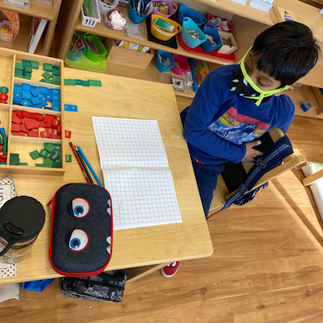Montessori in a Minute: Mathematics
- schooloffice67
- Oct 1, 2021
- 3 min read
Montessori philosophy is based on the idea that children have an “absorbent mind,” made up of sensitive periods of development at different ages. The absorbent mind is apparent as we watch children journey through our world looking closely at everything; where all experiences are interesting. Children examine how things work, what they’re made of, and what they do. They soak up language and sensorial data to better understand everything around them.
Children also have a mathematical mind. Many of the questions children have about the world are answered through mathematics. It is common to see 4-year-olds with an interest in one of the most vital math building blocks: enumeration.
Montessori mathematics doesn’t wait until children understand enumeration as other educational philosophies sometimes do. From the moment a child enters a Montessori classroom, they are offered a series of specially designed tools that offer concrete components to “absorb” typically abstract mathematics concepts.
The Value of Montessori Mathematics
Sensorial mathematics materials are introduced in our Toddler, Bridge Primary, and younger Primary students. For example, the Pink Tower instills concepts like sequence, order, and progression as students understand how each building block fits together to form the final tower. Children are also introduced to geometry at this age through tools like the geometric solids and the Geometric Cabinet. The act of repeatedly feeling and manipulating items that represent abstract concepts helps nurture mastery and deep understanding, rather than surface level memorization.
New tools are introduced once children are ready for enumeration and can understand verbal and visual numerical representations. These tools, including sandpaper numbers and number rods, help students connect these verbal and visual representations to the numerical concepts they have been practicing through their sensorial activities.
One of the most famous Montessori materials, the Bead Cabinet, is used by 3-year-olds up through middle school! The Bead Cabinet has the ability to physically represent numbers up to 100,000. The sheer amount of numbers this tool can represent makes it a vital tool for teaching equations in simple mathematics to algebra. The Multiplication Checkerboard is also used to teach multiplication and long division with a concrete representation. After students have a deep understanding of these concepts they move on to the Stamp Game where the concrete representations only make sense with a true base of knowledge. Once students are able to complete and understand these operations as abstract concepts, they no longer rely on these tools and move into fully abstract mathematical thought.
The Montessori in a Minute Series
Montessori schools have at least five key areas of learning in the Montessori environment: Practical Life, Sensorial, Language, Mathematics, and Culture. Montessori schools like Hudson Montessori School utilize specially designed tools, like those found in the Mathematics section, to promote experiential and sensorial learning that students can repeatedly practice at each age level. Often, these tools are self-correcting, allowing the child to check their work and adjust accordingly.
This Montessori In A Minute series regularly explores the unique benefits of Montessori philosophy, its fundamental materials, and areas of the classroom. For all parents at Hudson Montessori School, the school hosts monthly Parent Education Nights to learn all about the Montessori method and how the students learn curriculum components using a Montessori framework. The next session is October 6 at 6 p.m. on Sensorial and Math led by three of our Montessori teachers.
To learn more about Hudson Montessori School’s interdisciplinary, theme-based learning approach to education, the Montessori philosophy and methodology, or how the school fosters the love of learning for children age 2 to sixth grade, sign up for an open house tour.










Comments